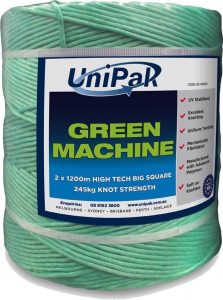Posted on September 12, 2022
Baling Twine Perks
There are many advantages to using baling twine in agricultural projects, but there are also some environmental drawbacks. For example, in rural areas, most baler twine is dumped in landfills. Landfills are areas designed to store and dispose waste materials and extend the land’s usable area. Additionally, most of the baling twine used in agricultural applications is often thrown away or burned, which produces toxic fumes.
 The best way to dispose of baling twine is to wrap it in a solid plastic bag, cardboard box, or bin. It will prevent the twine from getting caught in objects like trees or blowing away. Alternatively, some areas have baling twine drop-off programs. In addition, some towns and cities have programs for recycling this material. For more information, contact your local government and find out if baling twine is recyclable in your area.
The best way to dispose of baling twine is to wrap it in a solid plastic bag, cardboard box, or bin. It will prevent the twine from getting caught in objects like trees or blowing away. Alternatively, some areas have baling twine drop-off programs. In addition, some towns and cities have programs for recycling this material. For more information, contact your local government and find out if baling twine is recyclable in your area.
As a farmer, you may have noticed that many balers use this twine from www.unipak.com.au/baling-twine/ for packing hay. It is a great way to store hay and provides more space for livestock to move around. The bales are made of natural fibres, so it’s easy to mould them into the shape that best suits the needs of your livestock. They’re also safe to use and yield higher than other types of twine.
If you plan to store your bales outdoors, you may want to consider purchasing U-V stabilized twine. The twine is designed to prevent the bales from getting wet and broken in the field. It is also a good choice for environmentally friendly properties. Lastly, if you’re interested in storing your bales outside, sisal twine is ideal for lightweight bales. Lastly, if you’re using twine for other uses, you might consider choosing a specially made product.
The quality of your baler’s twine will determine the strength of the bales. A high-quality baler will have twine that is strong enough to withstand the weight of the bales. Depending on your baler and the hay you produce, you may need to invest in a bale with a higher knot strength than a small one. For larger bales, you may need knots with higher Kgf values.
It is essential to choose the correct baling twine for your specific machine. The weight, length and meter weight ratio of your twine is all important. Additionally, you’ll be able to customize your twine to suit your requirements. Baling twine should also be easy to use and clean. And a high-quality twine will increase your efficiency in baling. The benefits are plentiful, but it’s essential to do your research.
Ospreys are particularly susceptible to the effects of baling twine. These birds frequently pick up baling twine to use as nesting material. It can have devastating consequences for Osprey. Similarly, if you have small chickens or cats that eat hay, you’ll want to ensure that they don’t get into your bale. By ensuring that the twine is appropriately tied, you can prevent any ill effects that might result.
Baler twines have been refined over the years. In recent years, the industry has been able to create a unique material that combines high density, sufficient length and optimal cost per bale. Choosing the proper twine is essential for many reasons, including minimizing knotting and ensuring optimum press density. In addition, high-quality baler twine will be more resistant to damage from UV rays.
Besides its practical uses, baling twine is a green choice for farming. It can be dyed orange, blue, black, and natural. Depending on your needs, baling twine can even be used as a lead rein for your dog or as a harness for a horse. Another use for baling twine is in the construction of straw and hay. Aside from agricultural uses, it can also be used in other industries.
Plastic polymers are commonly used for baler twine. They are safer, practical, and environment-friendly. In addition, plastics help farmers save money and are a cost-effective option for agricultural applications. In addition to plastic polymers, baling twine is manufactured from various components, including sisal. The most important raw material is polypropylene, which guarantees high strength and softness. You can also use monofilament baling twine in your project, if necessary.
If you’re unsure whether to use polypropylene twine for agricultural purposes, you should try sisal baling twine. It is biodegradable, and it doesn’t cause any problems when it is broken down. Sisal twine is one of the most popular types of baler twine, but there are also varieties made of recycled fibre. Check with your local feed store if you’re unsure which is best for your needs.

